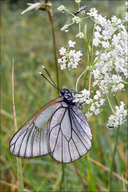|
|
click photo for larger file

Aporia crataegi
Black-veined White
|
Photographer: Dr. Amadej Trnkoczy
ID: 0000 0000 0715 0268 (2015-07-04)Copyright © 2015 Dr. Amadej Trnkoczy
|
|
INFORMATION PROVIDED WITH THE PHOTO
|
date of photo Jun 15, 2015
latitude 46.36086 longitude 13.70188
View on Google Maps.
location
Lower Trenta valley, right bank of river Soča, between villages Soča and Trenta, next to the trail from Trenta 2b cottage to abandoned farmhouse 'Strulc', East Julian Alps (Posočje, Slovenia)order
Lepidoptera
class Insecta
notes Slo.: glogova belinka - Habitat: Mountain pasture, moderately southeast inclined mountain slope; calcareous ground, dry and sunny place, exposed to direct rain, average precipitations ~ 3.000 mm/year, average temperature 7-9 deg C, elevation 620 m (2.050 feet), alpine phytogeographical region. - Comment: Aporia crataegi is another butterfly, which is widespread (from America over Europe and Asia to Japan) and quite common. These butterflies are frequently seen also in Trenta valley. They are quite big and beautiful in spite of the fact that they have no colorful decoration on their wings. Thin, almost completely translucent, silvery wings supported by a perfectly designed structure of black 'bones', hairy, black body and long antlers, white at the tip, could only be admired. The butterfly's caterpillars are bound to two feeding plants blackthorn (Prunus spinosa) and hawthorn (Crataegus sp.). Both are common in Trenta valley. Butterflies feed on nectar of flowers of many species including Betonica alopecuros (yellow flowers), Valeriana collina (whitish-pink flowers) and Pimpinella saxifraga (white) as shown on my pictures. All of them show females. Their front edge of forewings is brown and about one half of the terminal thicker part of the antlers is white, while males have black and white wings edge and only the tip of the thicker terminal part of the antlers is white spotted. - Aporia crataegi were once common in southern England. However, in 1920s they suddenly completely disappeared. Several attempts to reintroduce them failed. The real explanation why this happened remains unknown. The same is true for many regions in Europe where this species is in dramatic decline. - Ref.: (1) http://www.learnaboutbutterflies.com/Europe%20-%20Aporia%20crataegi.htm (2) http://www.lepiforum.de/lepiwiki.pl?Aporia_Crataegi (3) Fauna Europas, Bestimmungs lexikon, George Westermann Velag, Braunschweig (1997), translated to Slovenian, Mladinaka Knjiga, Ljubljana (1981).camera Canon G11, 6.1-30mm/f2.8-4.5
contributor's ID # Bot_887/2015_IMG8273 photo category: Animal - Invertebrate-Insect
|
MORE INFORMATION ABOUT THIS ANIMAL
|
| common names
Black-veined White (photographer)
View all photos in CalPhotos of Aporia crataegi Check Google Images for Aporia crataegi |
|
The photographer's identification Aporia crataegi has not been reviewed. Click here to review or comment on the identification. |
|
Using this photo The thumbnail photo (128x192 pixels) on this page may be freely used for personal or academic purposes without prior permission under the Fair Use provisions of US copyright law as long as the photo is clearly credited with © 2015 Dr. Amadej Trnkoczy.
For other uses, or if you have questions, contact Dr. Amadej Trnkoczy amadej.trnkoczy[AT]siol.net. (Replace the [AT] with the @ symbol before sending an email.) |
|
|
